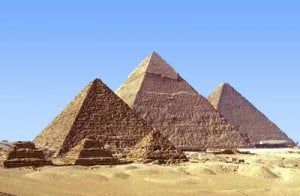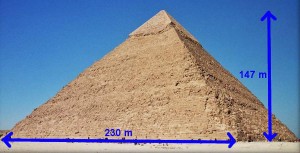
The Pyramids of Giza are an unfathomable creation by the Egyptians. These structures are one of the Seven Wonders of the World. They also make good math problems for students.
The Pyramids can be used when teaching volume of shapes. There are three main pyramids and the students will be looking at the volume of all three. This assignment could also go further, if just finding the area is too easy, by looking at similarity between the three pyramids. Students could find the area of all three pyramids and then look at similarity between the three to see how consistent the Egyptians were in their architecture. The problem can be modified to make it easier or more difficult for the given group of students.
CCSS.MATH.CONTENT.HSG.GMD.A.3
Use volume formulas for cylinders, pyramids, cones, and spheres to solve problems.*

When Pythagoras took a trip to Egypt, he noticed that the Egyptians improved the stability of their walls by using rope and a 3-4-5 triangle. The knots in the rope would be tied with 5 on the hypotenuse, 4 on the base, and 3 on the height of the pyramid. Additionally, the angle between the base and the hypotenuse of this triangle is 53.13 degrees whereas the angle of incline of the sides of the Pyramid of King Khafre are 53.1 degrees. It is possible that the Egyptians used the Pythagorean Theorem and special right triangles to create the Great Pyramids in Egypt. Using this picture as an introduction, a teacher could lead the students through a lesson in which they use the Pythagorean theorem and special right triangles to figure out the dimensions of a pyramid when only minimal information is given (solve the triangle). You could create a worksheet with different pyramids on it or have the students create 3-D models of the pyramids and write the dimensions on their models. You could even have the students check their work using Geogebra.
The following Common Core State Standard would be attached to the activity described above.
CCSS.MATH.CONTENT.HSG.SRT.C.8
Use trigonometric ratios and the Pythagorean Theorem to solve right triangles in applied problems
CCSS.MATH.CONTENT.7.G.B.6
Solve real-world and mathematical problems involving area, volume and surface area of two- and three-dimensional objects composed of triangles, quadrilaterals, polygons, cubes, and right prisms.
The pyramid is a great example of a real world problems and your student find the area and the surface area of the pyramids.